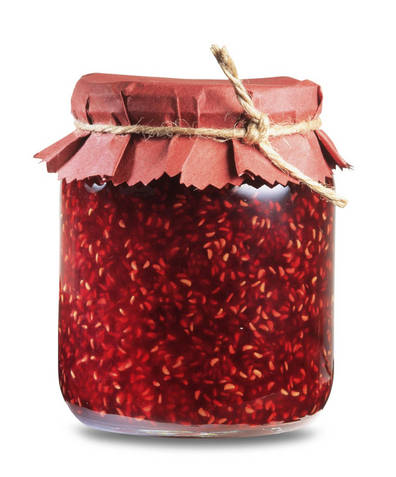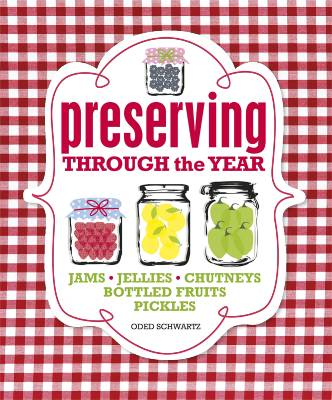Getting in a jam…
When the nights start drawing in and the leaves slowly begin to turn golden, homes around the country become filled with the smells of spicy chutneys and fruity jams bubbling away on stoves.
After all the excitement of the summer, autumn is also a welcome opportunity to hunker down and learn new skills, so when a colourful copy of the late Oded Schwarz’s Preserving Through The Year (Dorling Kindersley) landed on my lap, I couldn’t resist the opportunity to fill my flat with THE fragrance of the season.
Having never so much as attempted to make jam before, a quick call to my mum yielded some good advice: stick to plum as it’s so easy, she said. Beyond that, I was relying on the book.
Israeli Schwartz grew up with “pickling in the blood”.
“There are few things in life more enjoyable than producing your own pickles, relishes and sauces and consuming the fruit of your labour together with family and friends,” he writes. “In the Middle East, the love of preserved food crosses all cultural and religious boundaries.”
But when he moved to England in the Seventies, he was disappointed by the lack of variety and availability of preserves he’d grown up to believe were everywhere.
“The raw ingredients were all there: wonderful fresh fruit and vegetables and different types of meat and fish. So, armed with an extensive knowledge gleaned from my youth, I set out to develop and modify ancient recipes that would appeal to a Western palate.”
The result is a book stuffed with delicious-sounding ways to preserve all kinds of food throughout the year, with tempting titles from candied apricots and vanilla flavoured peach marmalade to guava jelly and mango chutney.
“During late summer and autumn, your kitchen should exude the delicious, sweet aroma of luscious fruit, spices and drying herbs,” writes Schwartz. “Winter is the best time to make marmalades, tidy your cupboards and plan the year ahead.”
The proof of the pudding, as they say, is in the eating and it was time for a preserving novice to put Schwartz’s plum jam recipe to the test.
A trip to my trusty local hardware store, equipped me with the basics: little waxed sealants, rubber bands, a jam funnel, a sugar thermometer and all-important labels.
The local grocer had a fresh stock of Victoria plums (which was lucky, as our own plums were maggot-ridden) – and I dug out a variety of jam pots I’d squirreled away all year.
Feeling more confident, I grabbed the only big stainless steel, thick-bottomed pan in the cupboard and popped the plums in with some water to mush down. Pouring in an entire bag of sugar was rather scary, but without it, jam never sets.
And that’s where the thermometer comes in.
As Schwartz explains in the book, jam is only ready to pot when it reaches setting point, or when the sugar thermometer shows 105 degrees. If you don’t have a thermometer, you can do the wrinkle test by pouring the jam onto a saucer, and leaving it to cool for a few minutes. Then gently push it with your finger and if it wrinkles, it has reached setting point.
Scooping out the dark, sticky, plum gloop with a ladle into my sterilised jars (washed and then baked in the oven for 10 minutes), I discovered my jam had caught on the bottom of the pan, perhaps from when I’d left it for a few minutes. So I avoided the burnt bits.
And the taste? Caramelised plums, but quite delicious.
Try it for yourself… or one of Schwartz’s more adventurous recipes.
For all the following recipes:
(Makes 1.75kg)
:: Special equipment: Preserving pan, sugar thermometer, sterilised jars and sealants
:: Shelf life: 2 years
PLUM JAM
INGREDIENTS:
1.25kg plums, stoned and halved or quartered if large
350ml water
1kg preserving or granulated sugar
WHAT TO DO:
Put the plums and water in the preserving pan. Bring to the boil, then reduce the heat and simmer for about 25 minutes, stirring occasionally or until the plums are soft.
Add the sugar, stirring until it has dissolved. Return to the boil and boil for 25-30 minutes or until the setting point is reached.
Remove the pan from the heat and leave to settle for a few minutes. Ladle the jam into the hot sterilised jars, then seal.
RASPBERRY JAM
INGREDIENTS:
1kg raspberries
1kg preserving or granulated sugar
Juice of one lemon
WHAT TO DO:
Layer the raspberries and sugar in the preserving pan. Cover with a cloth and leave overnight.
The next day, add the lemon juice to the pan. Bring slowly to the boil, stirring frequently until the sugar has dissolved.
Increase the heat and boil rapidly for 20-25 minutes or until the setting point is reached. Stir constantly towards the end of cooking to prevent it from sticking.
If wished, pass half the jam through a sieve to reduce the seed content, then return to the boil for 5 minutes.
Remove the pan from the heat and leave the jam to settle for a few minutes. Ladle into the hot sterilised jars, then seal.
ONION MARMALADE
INGREDIENTS:
1.25kg onions, sliced into thin rings
3 tbsp salt
1kg preserving or granulated sugar
500ml vinegar
1½ tsp cloves tied in a piece of muslin
2 tsp caraway seeds
WHAT TO DO:
Sprinkle the onions with the salt. Mix well and leave to stand for 1 hour. Rinse and dry. Put the sugar, vinegar, and muslin bag in the preserving pan.
Bring to the boil, then simmer for 5 minutes. Add the onions and caraway seeds. Return to the boil, skim, reduce the heat to minimum, and cook for 2-2½ hours, or until the syrup is thick and the onions are translucent and golden brown.
Remove the pan from the heat and leave the onions to settle for a few minutes. Ladle the mixture into the hot sterilised jars, then seal.
The marmalade is ready to eat immediately but improves with keeping.
FIG CHUTNEY:
INGREDIENTS:
1.25 litres red wine vinegar
500g light soft brown sugar
2 tbsp salt
1kg firm, slightly under-ripe black figs, sliced into rounds 1cm thick
500g onions, sliced into thin rings
250g pitted dates, coarsely chopped
150g fresh ginger root, finely shredded
2 tbsp sweet paprika
1 tbsp white mustard seeds
3 tbsp chopped fresh tarragon or 1 tbsp dried tarragon
WHAT TO DO:
Put the vinegar, sugar, and salt in the preserving pan, stirring until the sugar and salt have dissolved. Bring to the boil, then simmer for about 5 minutes.
Add the figs, onions, dates, and spices. Bring to the boil, then simmer for 1 hour, until most of the liquid has evaporated and the mixture is thick.
Remove from the heat, add the tarragon, and mix well.
Ladle into the hot sterilised jars, then seal. The chutney will be ready to eat in 1 month.
:: Preserving Through The Year by Oded Schwartz is published by Dorling Kindersley, RRP £16.99. Available now and at Amazon for £11.89 with Free Super Save Delivery
For more delicious recipes click here ←
Latest posts by Sally - Silversurfer's Editor (see all)
- Holiday hack: How to win a GHA DISCOVERY Titanium status upgrade - April 23, 2024
- 10 Money saving tips for gardeners - April 21, 2024
- Should smacking a child be banned in England and Northern Ireland? - April 17, 2024
- Enjoy the best of the UK on a Shearings coach holiday - April 17, 2024
- Blueberry & Lemon Curd Bread and Butter Pudding - April 16, 2024























